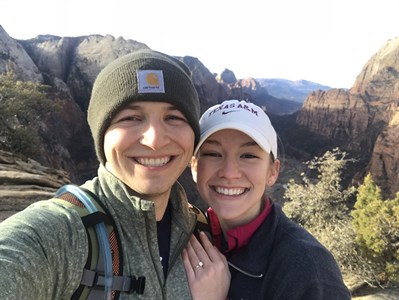
Spring Break has come and gone in a flash!
I traveled to Utah’s Zion National Park with my boyfriend, Spencer, and we camped for three days under the Utah stars. Being used to waking up at 6 a.m. for school, it wasn’t hard for me to adjust to our early-morning hikes, but for Spencer, it was a bit harder! Beating the Spring Break crowd is a priority, because being in nature surrounded by loud strangers is never ideal. My favorite hike was up Angel’s Landing, one of the most coveted spots to hike in North America. Half of the trail is a series of 21 brutal uphill switchbacks, which make your legs (and lungs) shaky like Jell-O. A sedentary, studying lifestyle has somehow failed to put me in peak mountain-climbing shape.
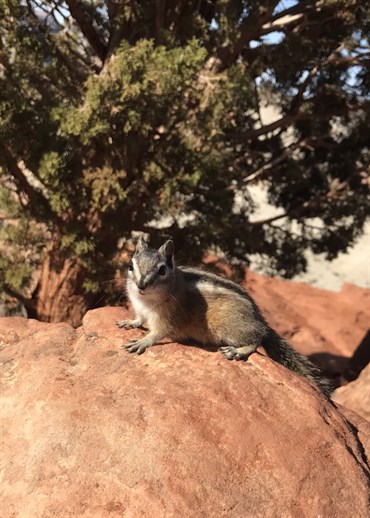
The last half of the hike has chains built into the mountain, a narrow rock path, and cliffs on either side of you. I kept telling myself, “Don’t look down.” But it never worked. I repeatedly looked down and kept scaring myself. Six people have died climbing that cliff face since 2004, so it must be taken seriously.
Unexpectedly, as we were watching the early morning sun cover the canyon, Spencer got down on one knee and proposed to me. I said yes, of course, but was too afraid to wear the ring down the mountain, so I put it back in the box until we got to stable ground at the bottom. I am very excited to finish my last year of vet school in the clinics, marry him, and start our life together in 2019!Once at the top of Angel’s Landing, you can see across the entire Zion Canyon that has been explored by humans for thousands of years. It was a breathtaking view and a great reward for the challenging trip up to the summit!
Our second hike was up to Observation Point, a little higher and lengthier than Angel’s Landing, but a much less terrifying hike. There was a family of chipmunks at the top that were feistier than any animal I have ever met. National parks tell you to “Please do not feed the wildlife” when they really should warn you that wildlife will sneak into your backpack and drag your PBJ out of it. I never knew something so adorable could be so mischievous!
After not showering for three days, we headed to Las Vegas to celebrate our engagement with family. Someone asked me, “How are you going to study when you have a wedding to plan?” and I really have no idea. Being a vet student leaves us with such little time to think about anything except for vet school, but I think I will have to take some steps back and prioritize what is important!
We also traveled to the Hoover Dam, which is only 30 minutes away from Vegas in Boulder City. It is so much bigger than I could have ever imagined, and I cannot imagine the feat that it was to build it in 1935 to block the Colorado River.
I was curiously wandering around and found a dog’s grave near the entrance. The plaque states that the dog rode the bus and accompanied the workers to their job sites every day. But then, one day, he was sleeping and was run over by a truck and was mourned by the workers and buried under the guard tower. Such a special tribute to man’s best friend!
My Spring Break was a very needed respite from the stresses of vet school, so that I am fully recharged and ready to take on my last semester and last full year of clinics. I am slightly regretful of the amount of things that piled up over the week off; however, I know I will find a way to catch up, like I always do.
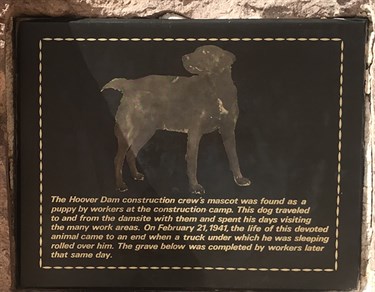 Along with tests, quizzes, and projects due this week, we are also getting ready for our Vet School Open House that is coming up this Saturday. I am volunteering to present a surgery simulation where we show what veterinary surgeons look like gowned, masked, and gloved-up in the operating room. It is always so much fun interacting with kids and adults who share our passion for animals and science. Hopefully, we can inspire some little minds to join this amazing and rewarding profession!
Along with tests, quizzes, and projects due this week, we are also getting ready for our Vet School Open House that is coming up this Saturday. I am volunteering to present a surgery simulation where we show what veterinary surgeons look like gowned, masked, and gloved-up in the operating room. It is always so much fun interacting with kids and adults who share our passion for animals and science. Hopefully, we can inspire some little minds to join this amazing and rewarding profession!

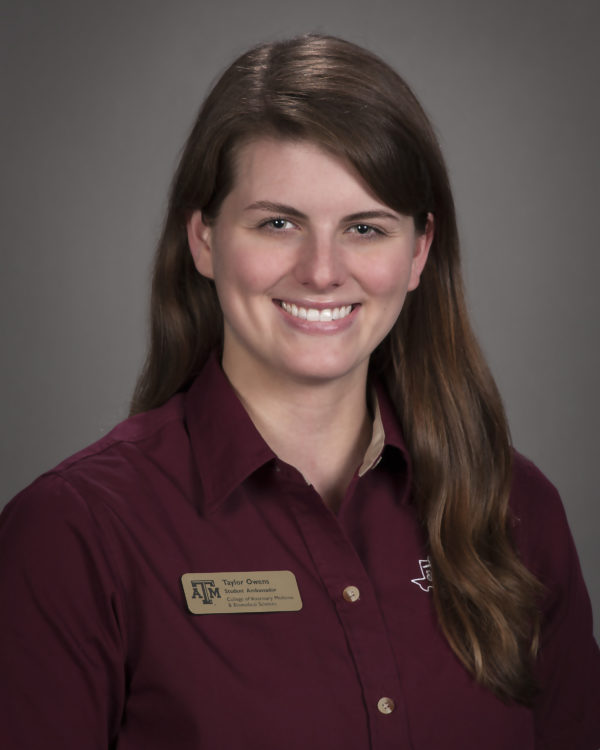 Last week we received our fourth-year clinical rotation schedules! During your fourth year of veterinary school, you complete 24, two-week clinical rotations throughout the different services in the Small and Large Animal Hospitals and have some time set aside throughout the year for externships and vacation.
Last week we received our fourth-year clinical rotation schedules! During your fourth year of veterinary school, you complete 24, two-week clinical rotations throughout the different services in the Small and Large Animal Hospitals and have some time set aside throughout the year for externships and vacation.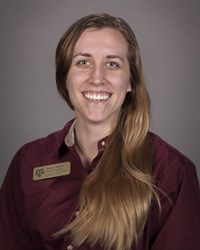 Well, I made it to my last semester before entering my fourth year of vet school, when I will be completing my clinical rotations in the Veterinary Medical Teaching Hospital! I can’t believe how fast the time has gone, but now, the real future planning starts. I am amazed at how much A&M is preparing us for our future. They put a lot of effort into providing us with resources and opportunities to grow in our profession and graduate confident in that knowledge.
Well, I made it to my last semester before entering my fourth year of vet school, when I will be completing my clinical rotations in the Veterinary Medical Teaching Hospital! I can’t believe how fast the time has gone, but now, the real future planning starts. I am amazed at how much A&M is preparing us for our future. They put a lot of effort into providing us with resources and opportunities to grow in our profession and graduate confident in that knowledge.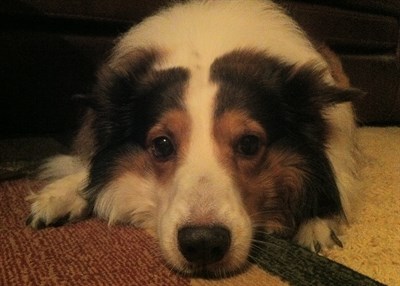 This is my family dog, Timmy.
This is my family dog, Timmy.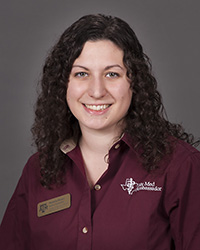 Now that Christmas break has come and gone and we are now back at school this week for spring semester, I am finally in the homestretch of my path of becoming a veterinarian. After my spring semester finals, I will be going straight into my clinical year this May. During our clinical year, each student takes a core set of rotations in both the small and large animal hospitals, since as veterinarians we are licensed to work on all species.
Now that Christmas break has come and gone and we are now back at school this week for spring semester, I am finally in the homestretch of my path of becoming a veterinarian. After my spring semester finals, I will be going straight into my clinical year this May. During our clinical year, each student takes a core set of rotations in both the small and large animal hospitals, since as veterinarians we are licensed to work on all species.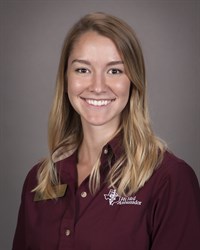 There is truly nothing like a finals week in veterinary school, where it seems you learn an entire semester in one night! There is so much to remember and never enough time, so you are forced to learn as much as you can, do your best, and still be satisfied with never knowing all of the information.
There is truly nothing like a finals week in veterinary school, where it seems you learn an entire semester in one night! There is so much to remember and never enough time, so you are forced to learn as much as you can, do your best, and still be satisfied with never knowing all of the information.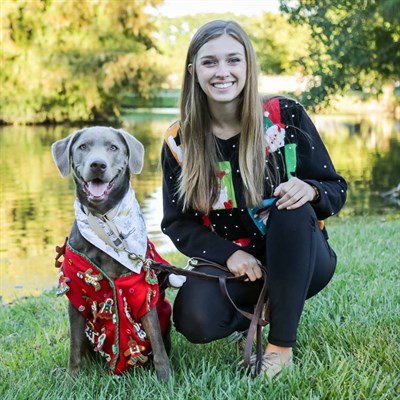
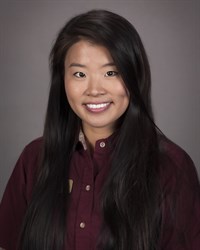 This upcoming Christmas break will be my last as a student, as my peers and I will be entering clinics immediately after the conclusion of the third-year veterinary curriculum. I have been meticulously planning to get the most out of the four-week break, during which I will be spending two weeks doing a veterinary externship in Dallas and the remaining time traveling with family and friends.
This upcoming Christmas break will be my last as a student, as my peers and I will be entering clinics immediately after the conclusion of the third-year veterinary curriculum. I have been meticulously planning to get the most out of the four-week break, during which I will be spending two weeks doing a veterinary externship in Dallas and the remaining time traveling with family and friends.